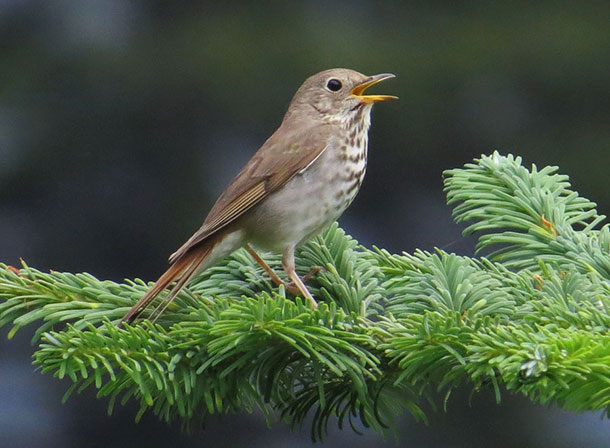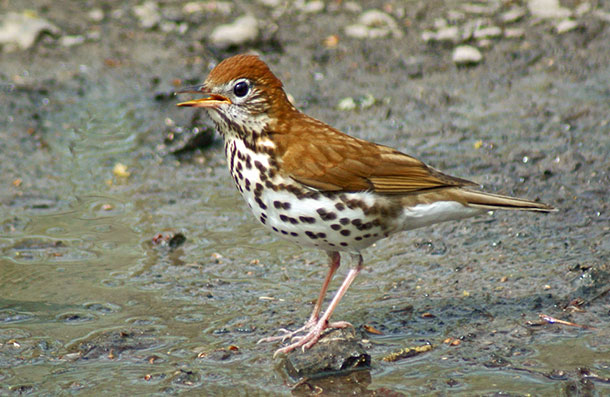BirdNote: Exquisite Thrush Song
Air Date: Week of June 15, 2018

A Hermit Thrush coos on the branch of a coniferous tree. (Photo: Mike Hamilton ©)
Thrushes are widely regarded to have some of the most musical bird songs. BirdNote’s Michael Stein explains how these birds use a special anatomical structure to create their elaborate songs.
Transcript
CURWOOD: In nature all creatures are beautiful in their own ways, even if we don’t always understand or appreciate them. But there is one genus of birds that has some of the easiest songs for humans to love, as Michael Stein tells us in today’s Bird Note.
[Wood Thrush song]
STEIN: Some believe the song of the Wood Thrush to be the most beautiful bird song in North America.
[Wood Thrush song]
Others select the song of the Hermit Thrush.
[Hermit Thrush song]
Still others name the singing of the Swainson’s Thrush.
[Swainson’s Thrush]
STEIN: So how do thrushes create such fine music? The answer is that the birds have a double voice box. Bird song emanates from a complex structure, unique to birds, called the syrinx. Syrinx is also the Greek word for the musical instrument we call panpipes, which have multiple pipes. It’s a fitting name for this essential part of a bird’s vocal anatomy, because, like panpipes, birds have two separate pipes to sing with. A fine singer like a thrush can voice notes independently and simultaneously from each half of its syrinx, notes which blend brilliantly as ethereal, harmonious tones.

A Wood Thrush sings on the muddy banks of a small body of water. (Photo: Greg Miller ©)
[Hermit Thrush song]
Fortunately for us, the results are lovely and haunting.
[Wood Thrush Song]
I’m Michael Stein.
[Wood Thrush song]
CURWOOD: For photos of these songsters, wing your way to our website, loe.org.
And by the way, the wood thrush typically migrates north to the US in Early April from wintering grounds in tropical forests from southern Mexico to Colombia. Over the past several decades, the wood thrush population has declined by 60 percent or more, with the loss of habitat cited as the major culprit. But you can still hear them today, mostly after the leaves come out in the Eastern deciduous forests.
And for your listening pleasure, here’s a longer recording of a wood thrush that Lang Elliot made on a late April day in a deep ravine in the Smoky Mountains, as part of his series Music of Nature.
[Wood Thrush Song]
Links
Listen on the BirdNote Website
More on how songbirds produce their tunes
Music of Nature: “Wood Thrush, Flautist of Nature” by Lang Elliott
Living on Earth wants to hear from you!
Living on Earth
62 Calef Highway, Suite 212
Lee, NH 03861
Telephone: 617-287-4121
E-mail: comments@loe.org
Newsletter [Click here]
Donate to Living on Earth!
Living on Earth is an independent media program and relies entirely on contributions from listeners and institutions supporting public service. Please donate now to preserve an independent environmental voice.
NewsletterLiving on Earth offers a weekly delivery of the show's rundown to your mailbox. Sign up for our newsletter today!
 Sailors For The Sea: Be the change you want to sea.
Sailors For The Sea: Be the change you want to sea.
 The Grantham Foundation for the Protection of the Environment: Committed to protecting and improving the health of the global environment.
The Grantham Foundation for the Protection of the Environment: Committed to protecting and improving the health of the global environment.
 Contribute to Living on Earth and receive, as our gift to you, an archival print of one of Mark Seth Lender's extraordinary wildlife photographs. Follow the link to see Mark's current collection of photographs.
Contribute to Living on Earth and receive, as our gift to you, an archival print of one of Mark Seth Lender's extraordinary wildlife photographs. Follow the link to see Mark's current collection of photographs.
 Buy a signed copy of Mark Seth Lender's book Smeagull the Seagull & support Living on Earth
Buy a signed copy of Mark Seth Lender's book Smeagull the Seagull & support Living on Earth

